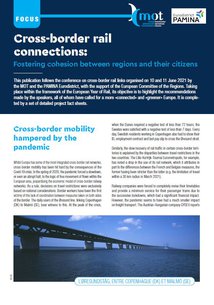Transport
Overview
Introduction
For several years now, border territories have been facing a continued increase in daily migration linked to the opening of the internal market and the practical implementation of the freedom of movement established by the European Treaties.
Different types of cross-border flows can be distinguished. Commuting flows constitute the most important phenomenon. For example, today it is estimated that every day more than 438,000 people cross the border from France to work in a neighbouring country. However, these flows of workers, while significant, coexist with other types of flow: local flows comprising short journeys for various everyday purposes (health, education, leisure and consumption) as well as long-distance transit flows.
This coexistence of local and international transport, using the same infrastructure, particularly roads, has major consequences on safety, leads to increased congestion and pollution, and is thus a major nuisance in certain cross-border conurbations.
More than ever, there is a need for public authorities to deal with this increase in cross-border mobility and focus on developing a transport offer tailored to the needs of border residents and the requirements of sustainable development of the territories concerned. Cross-border urban and interurban transport, by road and rail, is therefore a very important factor in the process of territorial integration in Europe.
In addition, the quality of transport provision is a key factor for territories’ economic attractiveness, and in particular for the attractiveness of conurbations on a European scale.
With its 2014-2020 Cohesion Policy the European Union has set the goal of “promoting sustainable transport and removing bottlenecks in key network infrastructures.” To that end, the Cohesion Fund will be able to support investments in Trans-European Transport Network (TEN-T) projects and in the creation of cross-border urban transport systems, preferably with low CO2 emissions.
For the next long-term EU budget 2021-2027, the Commission proposes to modernise Cohesion Policy. Among the five main objectives that will drive EU investments in 2021-2027: "a more Connected Europe, with strategic transport and digital networks". More info.
Photo : Le Léman express, train transfrontalier à la frontière franco-suisse, Grand Genève
Copyright : CFF



